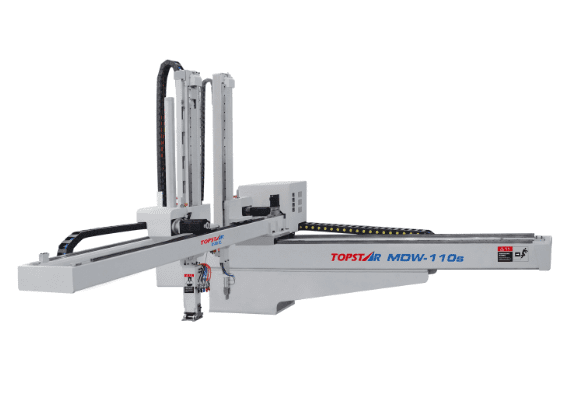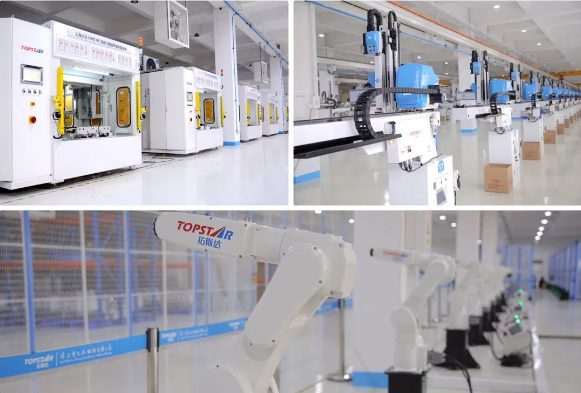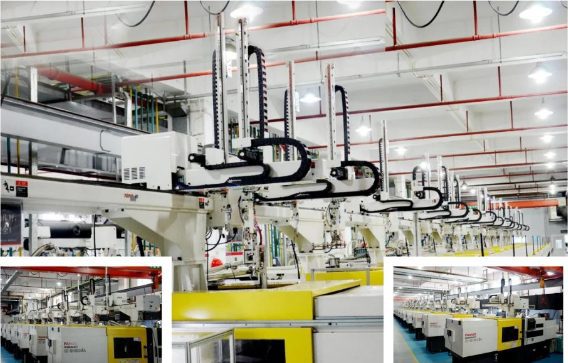Increased productivity with servo driven robot: your competitive advantage
2023/09/18 By Topstar

The injection molding industry is no stranger to technological advancements that streamline processes and increase efficiency. In recent years, servo driven robot integration has transformed automation efficiency in many sectors, providing manufacturers a significant competitive advantage. In today’s fast-paced industrial environment, where efficiency and precision are crucial, the role of servo-driven robots is becoming increasingly critical. In this article, we explore how servo-driven robots are reshaping the world of injection molding and giving companies the tools they need to thrive in a fast-paced and competitive market.
Servo driven robot in injection molding!
The injection molding process involves making complex and precise parts by injecting molten material into a mold. This approach has become a mainstay in manufacturing, producing everything from auto parts to consumer goods. However, achieving high-quality and consistent results has always been challenging, especially when removing finished parts from molds and managing complex tasks. Enter servo-driven robots, a technological leap that revolutionizes injection molding. These robots have servo motors that allow precise movement and speed control. This level of precision is critical in the injection molding process, where even minor errors can result in defective parts and increased waste. They provide the agility and accuracy to handle the most complex tasks, from mold removal to product placement.
Servo driven robot significantly improve efficiency and accuracy!
They significantly impact the efficiency and precision of injection molding operations. Traditional pneumatic robots rely on air pressure and lack the delicate control servo drive systems provide. This limitation often results in slower-than-expected cycle times, resulting in a decrease in overall productivity. In contrast, servo-driven robots can perform actions with incredible precision and speed. They can precisely control the movement of the mold and extract the finished part with minimal force. This not only reduces the risk of damage to precision components but also reduces cycle times. Manufacturers can produce more parts in less time, increasing productivity and saving costs.

Reduce waste and improve quality!
Waste reduction is a top priority for the injection molding industry. Defective parts, rework, and wasted materials can severely impact a company’s bottom line. They play a vital role in reducing waste by performing their tasks consistently and accurately. They must adapt seamlessly to different workloads and environments. These robots deliver consistent and reliable results, whether it’s pick-and-place tasks in manufacturing, complex electronics assemblies, or delicate medical procedures. Their versatility and precision enable businesses to optimize processes, reduce errors, and ultimately increase productivity. Additionally, their accuracy ensures that each part is handled with gentleness and care, reducing the chance of damage during production. This increases the proportion of defect-free parts and improves overall product quality.
Flexibility to complete complex tasks
Injection molding often involves complex tasks such as over-molding (molding one material over another) or insert molding (putting a prefabricated component into a mold before injection). Servo-driven robots excel at handling these complex procedures with ease. Their precise movement control allows them to insert details accurately and consistently, ensuring every part meets quality standards. Additionally, their flexibility to adapt to different tasks makes them ideal for injection molding setups requiring fast switching between molds and materials.

The future of servo-driven robot injection molding
With the emergence of artificial intelligence, machine learning continues to advance, making these robots more intelligent and adaptable. They can learn from experience, make real-time decisions, and work alongside humans collaboratively and safely. Additionally, integrating the Internet of Things (IoT) enables remote monitoring and predictive maintenance, reducing downtime and increasing overall efficiency. The ability to connect and communicate with other machines and systems opens up new possibilities for seamless automation across industries.
Competitive advantages of servo driven robot
As automation technology advances, servo-driven robots will continue to evolve, further enhancing their capabilities and impact on the industry. And we at Tostar have always been at the forefront of this technology and industry. We will thrive in the highly competitive field of injection molding and provide high-quality products with higher efficiency and cost-effectiveness. Servo-driven robots are more than just tools; They are a strategic advantage that can propel companies to new heights in the dynamic manufacturing world.
TRENDING POSTS
- What factors can cause delays in the injection molding process of plastic molding machine? 2023/09/18
- Exhibition Review| Topstar participates in InterPlas Thailand 2024 2023/09/18
- Star Case | Topstar helps Santong upgrade its intelligent plant 2023/09/18
- Topstar Special | National Science and Technology Workers Day 2023/09/18
HOT TOPIC
- .ervo motor-driven linear robots
- 1.0 guangdong topstar technology co. ltd
- 1.0 topstar china
- 1.0 topstar robot
- 11
- 2
- 21
- 23
- 3 axis robot
- 3 axis robots
- 3 in 1 Compact Dehumidifying Dryer
- 3-axis robot
- 3-axis robots
- 39
- 41
- 460T injection molding machine
- 5-axis CNC machine
- 62
- 90 ton injection molding machine
- accuracy
- Air Chillers
- all electric injection molding machine
- all electric injection molding machines
- All-electric injection molding machines
- and overall production quality. Therefore
- AP-RubberPlas
- automated injection molding machine
- Automation changed engineering
- automation of injection molding robots
- automotive parts injection molding
- auxiliary machine
- Bench Injection Molding Machine
- Cabinet dryer manufacturers
- Cabinet dryers
- chiller
- CNC Drilling Machine
- CNC Drilling Machines
- cnc engraving machine manufacturer
- cnc laser cutting machine manufacturer
- CNC machine
- CNC Machine Center
- CNC Machine for Sale
- CNC Machine Manufacturing
- CNC Machine Tool
- CNC machine tool product
- CNC Machining Center
- CNC wood carving machine
- Cooling system
- Cross-Walking Single Axis Servo Cylinder Robot
- Cross-Walking Single-Axis Servo Cylinder Robot
- Cross-Walking Three-Axis/Five-Axis Servo Driven Robot
- cross-walking three-axis/five-axis servo-driven robot
- Dehumidifier Dryer
- Dehumidifying Dryer
- delta parallel robot
- Desktop Injection Molding Machine
- Desktop injection molding machines
- Desktop Molding Machine
- desktop plastic injection machine
- Desktop Plastic Injection Molding Machine
- direct clamp injection molding machine
- Direct clamp injection molding machines
- Dosing & mixing system
- Drilling Centers
- Drying and dehumidification system
- drying and dehumidifying equipment
- Drying and Dehumidifying System
- drying system
- effective and efficient. Cabinet dryers are also used in other industries where large quantities of material need to be dried
- efficient injection molding machine
- elbow hydraulic injection molding machines
- electric injection molding machine
- electric injection molding machines
- energy-efficient injection molding robot
- energy-efficient water chiller
- energy-efficient water chillers
- energy-saving injection molding machine
- etc. Among injection molding robots
- exhibition
- features of CNC machine
- Feeding And Conveying System
- Five Axis Machine Center
- Fully automatic injection molding machine
- Gathering Topstar
- giant injection molding machine
- GMU-600 5-Axis Machining Center
- Granulating & Recycling System
- Heavy duty injection molding machine
- High-precision electric molding machines
- high-precision plastic molding machines
- high-speed all electric injection molding machine
- high-speed electric injection molding machine
- High-Speed Packaging Injection Molding
- Honeycomb rotor dehumidifier
- horizontal injection molding machine
- Horizontal Injection Molding Machines
- Horizontal Injection Moulding Machine
- Horizontal Mixer manufacturer
- How The CNC Machine Works
- hybrid injection molding machine
- hydraulic injection molding machine
- Hydraulic Injection Molding Machines
- in this article
- Industrial robot
- Industrial Robot Chinese brand
- industrial robot parts
- industrial robot supplier
- Industrial robots
- Industry Chain
- Injection Manipulator
- injection manipulator robot
- injection mold machines
- Injection molding
- Injection molding automation
- Injection Molding Automation Solution
- injection molding dryer
- Injection molding equipment
- injection molding hopper dryer
- Injection molding machine
- injection molding machine brand
- Injection Molding Machine Factory
- Injection Molding Machine Manufacture
- Injection molding machine manufacturer
- injection molding machine manufacturers
- Injection molding machine procurement
- injection molding machine robotic arm
- injection molding machine with a robot
- Injection molding machines
- injection molding material dehumidifying
- injection molding plant
- injection molding process
- Injection Molding Robot
- injection molding robot arm
- Injection molding robot automation
- Injection molding robotic arm
- injection molding robots
- Injection moulding machine
- injection moulding machines
- Injection Moulding Robots
- Injection Robot
- Injection robot arm
- Injection robot manufacturer
- Injection robot wholesale
- injection robots
- intelligent injection molding machines
- intelligent mold temperature
- intelligent mold temperature controller
- Intelligent mould temperature controller
- Introducing Injection Robot
- It is the best choice for drying large quantities of material at once. Cabinetmakers use these machines because they are fast
- Large flow water type mold temperature controller
- large injection molding machine
- large injection molding machines
- Learn what industrial automation and robotics is
- linear robot
- linear robots
- low speed sound-proof granulator
- machine plastic molding
- make sure to add some! Improvements (2) Keyphrase in introduction: Your keyphrase or its synonyms appear in the first paragraph of the copy
- manipulator machine
- manufacturing
- medical grade injection molding machines
- Medical Injection Molding
- medical injection molding machine
- medical injection molding machines
- micro injection molding machine
- middle speed granulator
- Mini CNC machine manufacturers.
- mobile cover making machine
- Mold Temperature Control System
- mold temperature controller
- mold temperature controllers
- molding machine
- molding material Dehumidifying System
- mould temperature control system
- mould temperature controller
- mould temperature controllers
- New electric injection molding machine
- nitrogen dryer manufacturer
- nitrogen dryer system manufacturer
- Oil type mold temperature controller
- Oil type mold temperature controllers
- open day
- optical component injection molding
- Outbound links: No outbound links appear in this page. Add some! Images: No images appear on this page. Add some! Internal links: No internal links appear in this page
- packaging injection molding
- PET Preform injection molding
- phone case maker machine
- phone case making machine
- phone cover making machine
- plastic bottle making machine
- plastic bottle manufacturing
- plastic bucket making machine
- plastic bucket manufacturing
- Plastic chair making machine
- plastic forming equipment
- plastic hopper dryer
- plastic injection machine
- plastic injection machines
- plastic injection molding
- Plastic injection molding equipment
- Plastic injection molding machine
- Plastic Injection Molding Machines
- plastic injection moulding machine
- plastic injection moulding machines
- plastic injection robot
- plastic molding
- Plastic Molding machine
- plastic molding machine 1
- Plastic Molding Machines
- plastic molding press
- plastic moulding machine
- plastic phone case making machine
- plastic-molding machine
- powerful granulator
- Powerful Type Sound-Proof Granulator
- precision injection molding
- precision injection molding machines
- production of plastic seats
- pure water mould temperature controller
- Robot injection molding
- robot injection molding machine
- robot manufacturing companies
- Robotic arm for injection molding machine
- robotic injection molding machines
- robotics in injection molding
- SCARA robot
- SCARA robots
- Service-oriented manufacturing
- Servo Cylinder Robot
- servo driven robot
- Servo Driven Robots
- servo injection molding machine
- servo injection robots
- servo motor-driven linear robots
- servo-driven 3-axis robot
- Servo-Driven Robot
- Setup of injection machine
- Silicone Injection Molding Machine
- six-axis industrial robot
- Stainless Hopper Dryer
- Stainless Hopper Dryers
- star club
- swing arm robot
- take-out robot
- take-out robots
- the choice between servo-driven robots and hydraulic robots will have a certain impact on efficiency
- the most popular injection molding machine
- the type of injection molding robot
- TMII injection molding machine
- toggle clamp injection molding machine
- Toggle Hydraulic Injection Molding Machines
- toggle injection molding machine
- Top 10 brands of injection robots
- Topstar
- Topstar Engineering
- Topstar Industrial Robots
- Topstar injection molding intelligent
- Topstar Scara Robots
- Useful Injection molding machine
- Vertical machining centers
- volumetric type blender
- water chiller
- water chillers
- water distributor
- water type mold temperature controller
- Water Type MoldTemperature Controller
- Water-Type Mould Temperature Controllers
- We often face choices when performing injection molding. We will choose the type of injection molding machine
- wholesale of injection molding machines
- x carve CNC
- 热门查询 点击次数 展示 排名 topstar
